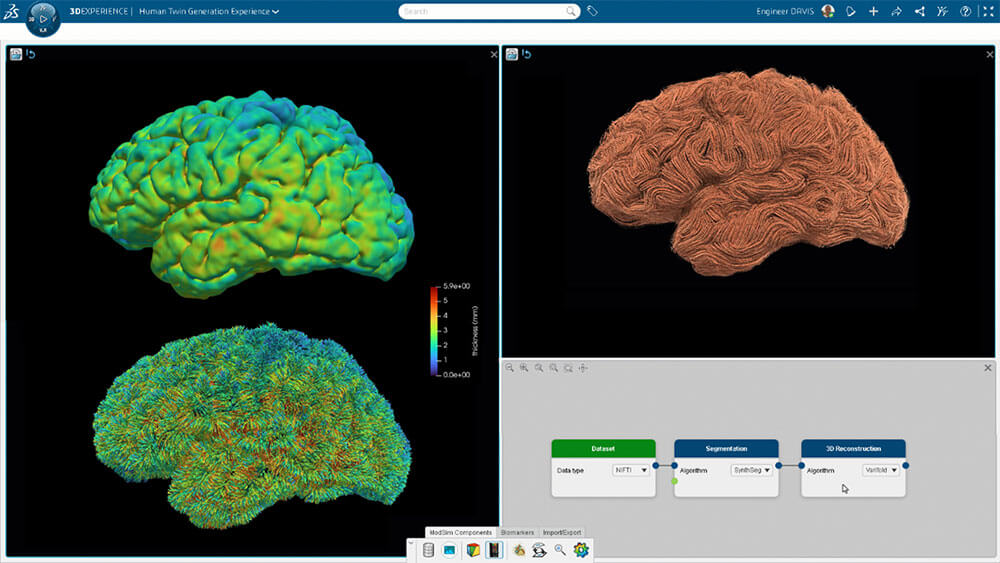Virtual twin for healthcare
Virtually and accurately representing an individual or physiological system.
Building a virtual twin for healthcare
Virtual twins have become an indispensable asset in the aeronautics and mobility industries, where virtualization has enabled considerable progress in terms of safety, quality, ecological footprint, and cost-effectiveness.
Thanks to personalized virtual twins of organs, metabolism, and cancerous tumors, MEDITWIN will enable healthcare professionals to provide the most appropriate care tailored to each individual.
MEDITWIN will build on the experience accumulated by Dassault Systèmes and its partners over many years in the field of digital twins for healthcare, such as Dassault Systèmes' Living Heart Project initiative, the Living Brain, and the activities of the PEPR Digital Health program co-directed by INRIA and INSERM, to name a few examples.

The scientific contributions of the MEDITWIN project will enable the creation of a virtual experimental environment in which it will be possible to test interventions, simulate the effect of treatments, and predict the evolution of a given individual's state of health, guaranteeing a degree of accuracy.
Here are some concrete examples of applications developed in the fields of cardiology, oncology, and neurology:
- Personalized surgery planning
- Adjustment of treatments based on metabolic or pharmacological simulations
- Comparison of diagnostic and therapeutic scenarios to support clinical decision-making
Addressing scientific challenges for the creation of realistic virtual twins
The consortium will address many technological challenges for the creation of these twins, mainly focusing on:
- Exploring new forms of 3D representation
We aim to define appropriate representation spaces to deal with human anatomy and physiology, which are naturally 3D, variable over time, and unique to each individual. This new representation will enable the unification of all multimodal and noisy medical data within the virtual twin. These representations will open up unprecedented perspectives for the analysis and understanding of diseases.

- Excellence in numerical simulation technologies
In order to make the virtual twin simulable, it is necessary to characterize biophysical evolution models (laws of growth, deformation, mechanical or electromagnetic activity, biochemical processes, etc.) based on either real or synthetic observations.
Taking into account uncertainty in data and models, particularly due to inhomogeneous tissues, will be one of the challenges to be addressed. The simulations developed will help create a unique resource for understanding complex processes.

- The development of a new generation of AI based on knowledge and expertise
New disruptive Artificial Intelligence technologies are needed to address scientific challenges, from the generation of compliant virtual organs to the real-time simulation of complex problems. The models will be guided by knowledge of physics and biology to create representation spaces with a high level of confidence and robustness.
- Facilitating system exchange and compatibility
All of this will be made possible through the interoperability systems which will be implemented in the project, which will enable natural communication between all information systems. These new ontologies will enable the automatic indexing of heterogeneous data provided by all the partners (text, images, 3D models).
Understanding, explaining, supporting: a new Therapeutic Experience and Medical Practice
The solutions developed also become tools for explanation, dialogue, and follow-up. By visualizing the impact of a disease or treatment, they facilitate patient understanding, strengthen the practitioner-patient relationship, and promote therapeutic engagement.
In particular, they will make it possible to:
- Illustrate the mechanisms of action of a treatment to explain its benefits or side effects
- Co-construct a care plan by making the possible choices visible
- Limit errors through a prediction-based approach
- Optimize healthcare costs through prevention and targeted monitoring
The Virtual Twin in the Transformation and Development of New Healthcare Practices
The use of virtual twins in medicine paves the way for a major transformation: it will enable a shift from a reactive approach to predictive, personalized, and proactive medicine.
This translates into the ability to simulate treatments on a virtual representation of a patient before applying them, to anticipate the risks of disease or complications, or to plan safer surgical procedures. Adapting the virtual twin with real-world data (connected sensors or other sources) will also optimize remote patient monitoring.
These tools are already recognized as a lever for the future of healthcare, as illustrated in Dassault Systèmes’ white paper on next-generation precision medicine.
They also hold strong potential for clinical research, for instance through virtual clinical trial enrichment initiatives supported by the FDA.
